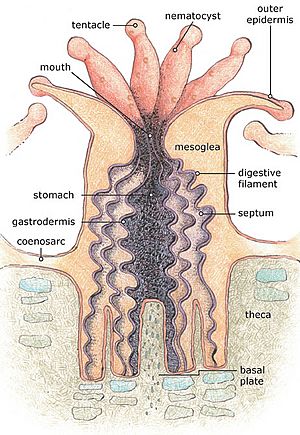Polyp facts for kids
Polyps are tiny sea animals that look a bit like a vase or a tube. They are one of two main shapes that cnidarians can have. The other shape is called a medusa, which is like a jellyfish. Polyps usually have a body shaped like a vase, with tentacles around their mouth. These tentacles help them catch food.
What are Polyps?
Polyps are part of a group of animals called cnidarians. This group includes animals like corals, sea anemones, and jellyfish. Many polyps stay attached to something, like the seafloor or a rock. This means they are sessile, which is a fancy word for staying in one place.
How Polyps Reproduce
Polyps can make more polyps in a few different ways.
- Budding: This is a type of asexual reproduction. It's like a small bump, or "bud," grows on the side of the parent polyp. This bud then grows into a new, complete polyp. Sometimes, this new polyp stays attached to the parent, forming a colony.
- Sexual Reproduction: Some polyps can also reproduce sexually. This usually involves releasing tiny eggs and sperm into the water. When they combine, they can form new polyps.
Polyp Colonies
Many polyps live together in large groups called colonies. When polyps reproduce by budding, the new polyps often don't separate from the parent. Instead, they stay connected, building a bigger and bigger group.
- Coral Reefs: The amazing coral reefs you see in the ocean are actually huge colonies of tiny coral polyps. These polyps create a hard, stony skeleton around themselves, which builds up over time to form the reef. These colonies can become very large and are home to many other sea creatures.
Polyps and Jellyfish Life Cycles
Jellyfish, which belong to a group called Medusozoa, have an interesting life cycle that includes both polyp and medusa stages.
- Polyp Stage: Many jellyfish start their lives as tiny polyps. These polyps are often attached to the bottom of the ocean or another hard surface.
- Medusa Stage: The polyps then start to make tiny jellyfish, called medusae, through asexual reproduction. These tiny jellyfish swim away from the polyp. They grow bigger by eating small things in the water, like plankton. Once they are grown, these jellyfish can reproduce sexually, and their offspring might turn into new polyps, starting the cycle all over again!



